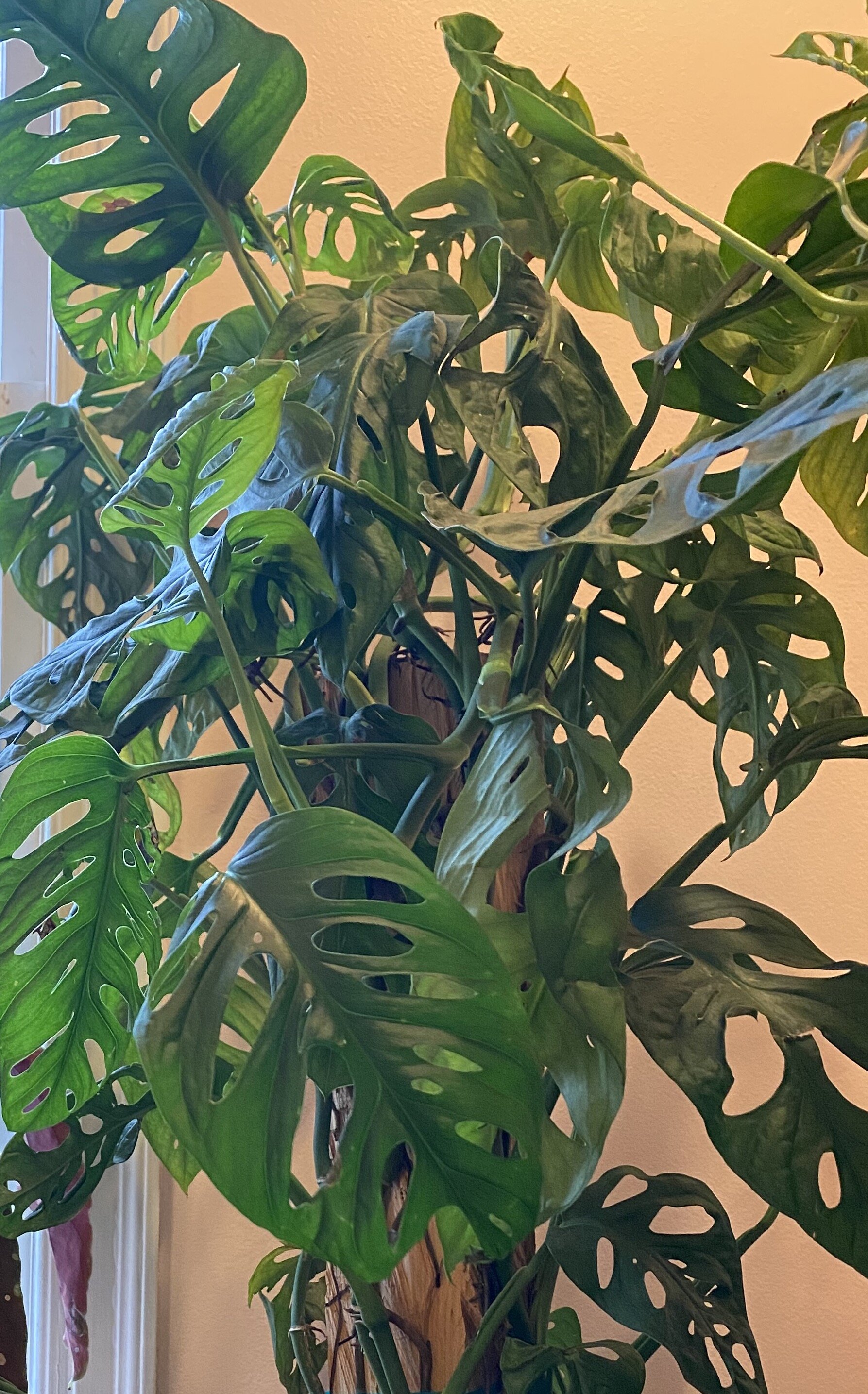Monstera Siltepecana.
This is a very juvenile Siltepecana. As the plant grows, it will require a coir pole to climb. As it climbs, the leaves will get larger and larger until they begin to get the very monstera-esque appearance that we all know and love- fenestrations and “holes.”
This baby is currently living on my plant cart a short distance away from a west window with a supplementary grow light. The light is gentle, which suits this plant well. There’s a humidifier serving the area and light air movement from the ceiling fan. All of these factors combine to create really nice conditions for a young plant. Due to the smaller terra-cotta pot with a chunky soil, this plant needs to be checked more frequently for dryness.
Monstera Adansonii “Swiss Cheese Vine.”
There’s a lot of talk about the “wide leaf” and “narrow leaf” forms of this plant. I do have both plants and I treat them the same. Both like humidity and bright light. This larger, totem-bound plant lives next to an east window and a northern facing sliding glass door where it also has a humidifier. The smaller “narrow leaf” plant lives on a shelf where it receives indirect light from both a south and an east window. This plant doesn’t have supplementary humidity, but it gets an occasional misting. A third plant, the “Trending Tropicals” Adansonii that was the subject of a blog post or two, has since been potted in with the large Adansonii totem. A final and new plant, a 6-7 ft. long “wide”leaf” Adansonii lives on a high shelf receiving exposure from East, north and west windows, All of the plants grow quickly when they’re happy. They can be super finicky plants when it comes to water. The biggest issue is to be careful and consistent. They’ve been known to throw yellow or brown leaves if the watering schedule isn’t just right for them. A moisture meter helps, look for the gauge to read around 2-3 before watering. On the dry side, but not bone dry. This does seem to help with leaf yellowing and the plants are happier. Take care to mist these plants whenever possible as they seem to be a plant that enjoys getting its leaves wet regularly. Be aware: misting will not ever raise the humidity levels inside the home - so luckily that’s not the goal. What it will do is refresh the leaves. In their natural environment, these plants would have water on their leaves off and on throughout the day. Monstera Adansonii has more papery, rough leaves (on a micro level) than say, the glossy feel of Monstera Delicious or Peru. For that reason, I find that Adansonii (and Siltepecana, who has a similar feeling to the leaves) are more sensitive to and appreciative of humidity and moisture on the leaves.
Some Tips:
This is not a plant that likes to be over-potted. Try a terra-cotta pot a size up from the nursery pot if it’s necessary to repot. If it isn’t necessary, a cache pot will spruce things up for you in the mean time. Give your misting hand a workout, nit to raise humidity but to give the leaves a boost. Trust me, they like getting wet. This is a light feeder, but it does like the occasional fertilizer. Once a month is good when it’s in active growth. With this plant, it all boils down to water and humidity.
Monstera Karstenianum “Peru.”
This plant is a climber by nature, and will appreciate a coir pole to climb. “Peru” prefers a chunky mixture to allow water to drain freely and oxygen into the root area although, this isn’t a picky plant. Don’t over-pot, don’t overwater, give it medium light and it’ll love you. Overwatering on this plant can lead to yellowing leaves, although yellowing can also happen during transitional periods for “Peru.” Humidity is alway a plus. For a point of reference, this plant lives 3-4 feet away from a west window and also has a grow light a few feet above where it sits. There is a humidifier within a couple of feet, and it receives water every 7-10-ish days during the growing season. About one watering per month includes a fertilizer. “Peru” can grow fast, but you’ll only get those big gorgeous leaves when it’s climbing. The plant knows it’s secure and stable when it digs in, and it’ll be happiest with that security.
Monstera Deliciosa.
The plant that has inspired thousands of plant lovers to become plant owners. It’s not the plant to buy if you want nice and tidy. In nature, this plant is an epiphyte. It grows in tree crotches and crevices, sending out adventitious roots to help it stabilize as it climbs higher into the tree canopy. It’s important not to cut off these roots on an indoor plant, as they gather moisture in the form of humidity from the air. As my plant has grown to a larger size, I’ve oddly noticed that I water it less. It is more established, though not yet mature enough to develop fenestration in the leaves. It lives and has always lived in an East window. It gets direct morning sun and loves it. It contributes to the little ecosystem in my home by providing dappled sunlight through its many leaves to several other Aroids that live under its canopy. Although this plant does have a humidifier, Monstera Deliciosa can deal with normal household humidity. A humidifier will certainly help humans and plants alike, though.











